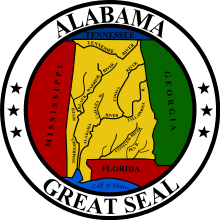Birmingham District
The Birmingham District is a geological area in the vicinity of Birmingham, Alabama where the raw materials for making steel, limestone, iron ore, and coal are found together in abundance. The district includes Red Mountain, Jones Valley, and the Warrior and Cahaba coal fields in Central Alabama.
Industrial development
The industrial development of these resources began, in limited fashion, before the American Civil War (attracting the attention of Wilson's Raiders in the course of that conflict).
Beginning in 1871 with the founding of the City of Birmingham and the construction of the first blast furnaces, the development of the district enjoyed explosive growth, slowed only by a deficit of skilled labor and investment capital. This boom earned for Birmingham the nickname "The Magic City" and also spurred the growth of several independent industrial cities and dozens of company towns.
Documentation and preservation
As the steel-making industry has diminished in its economic importance to the district, many of the sites have been abandoned or dismantled. Preservationists are attempting to document and preserve the physical evidence of Birmingham's industrial history. In the spring of 1993 a large-scale survey was undertaken for the Birmingham Historical Society and the Historic American Buildings Survey/Historic American Engineering Record. The results of that survey were published in the book Birmingham Bound.
References
- Armes, Ethel (1910). The Story of Coal and Iron in Alabama. Tuscaloosa, Alabama: Birmingham Chamber of Commerce. ISBN 0-912221-03-8.
- Lewis, W. David (1994). Sloss Furnaces and the Rise of the Birmingham District: An Industrial Epic. Tuscaloosa, Alabama: Univ. of Alabama Press. ISBN 0-8173-0708-7.
- Morris, Philip & Marjorie Longenecker White (1997). Birmingham Bound, An Atlas of the South's Premier Industrial Region. Birmingham, Alabama: Birmingham Historical Society. ISBN 0-943994-22-5.
- White, Marjorie Longenecker (1981). The Birmingham District: An Industrial History and Guide. Birmingham, Alabama: Birmingham Historical Society. ISBN 0-943994-00-4.
Coordinates: 33°31′N 86°48′W / 33.517°N 86.800°W
